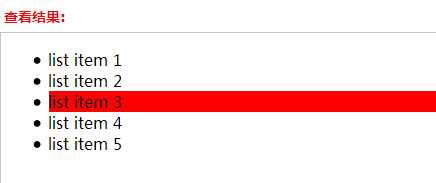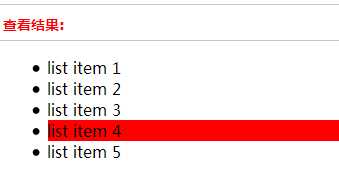标签:item 1 遍历 负数 round 属性 highlight 引用 length asc
<!DOCTYPE html>
<html>
<head>
<style>
div { width:60px; height:60px; margin:10px; float:left;
border:2px solid blue; }
.blue { background:blue; }
</style>
<script type="text/javascript" src="/jquery/jquery.js"></script>
</head>
<body>
<ul>
<li>list item 1</li>
<li>list item 2</li>
<li>list item 3</li>
<li>list item 4</li>
<li>list item 5</li>
</ul>
<script>$(‘li‘).eq(2).css(‘background-color‘, ‘red‘);</script>
</body>
</html>
eq(index) 方法将匹配元素集缩减值指定 index 上的一个。
index:整数,指示元素的位置(最小为 0)。如果是负数,则从集合中的最后一个元素往回计数。
上面的例子调用的结果是为项目 3 设置了红色背景。请注意,index 是基于零的,并且是在 jQuery 对象中引用元素的位置,而不是在 DOM 树中
$(‘li‘).eq(2).css(‘background-color‘, ‘red‘);

如果提供负数,则指示从集合结尾开始的位置,而不是从开头开始。
$(‘li‘).eq(-2).css(‘background-color‘, ‘red‘);

如果无法根据指定的 index 参数找到元素,则该方法构造带有空集的 jQuery 对象,length 属性为 0
$(‘li‘).eq(5).css(‘background-color‘, ‘red‘);

标签:item 1 遍历 负数 round 属性 highlight 引用 length asc
原文地址:http://www.cnblogs.com/yi11/p/6871676.html